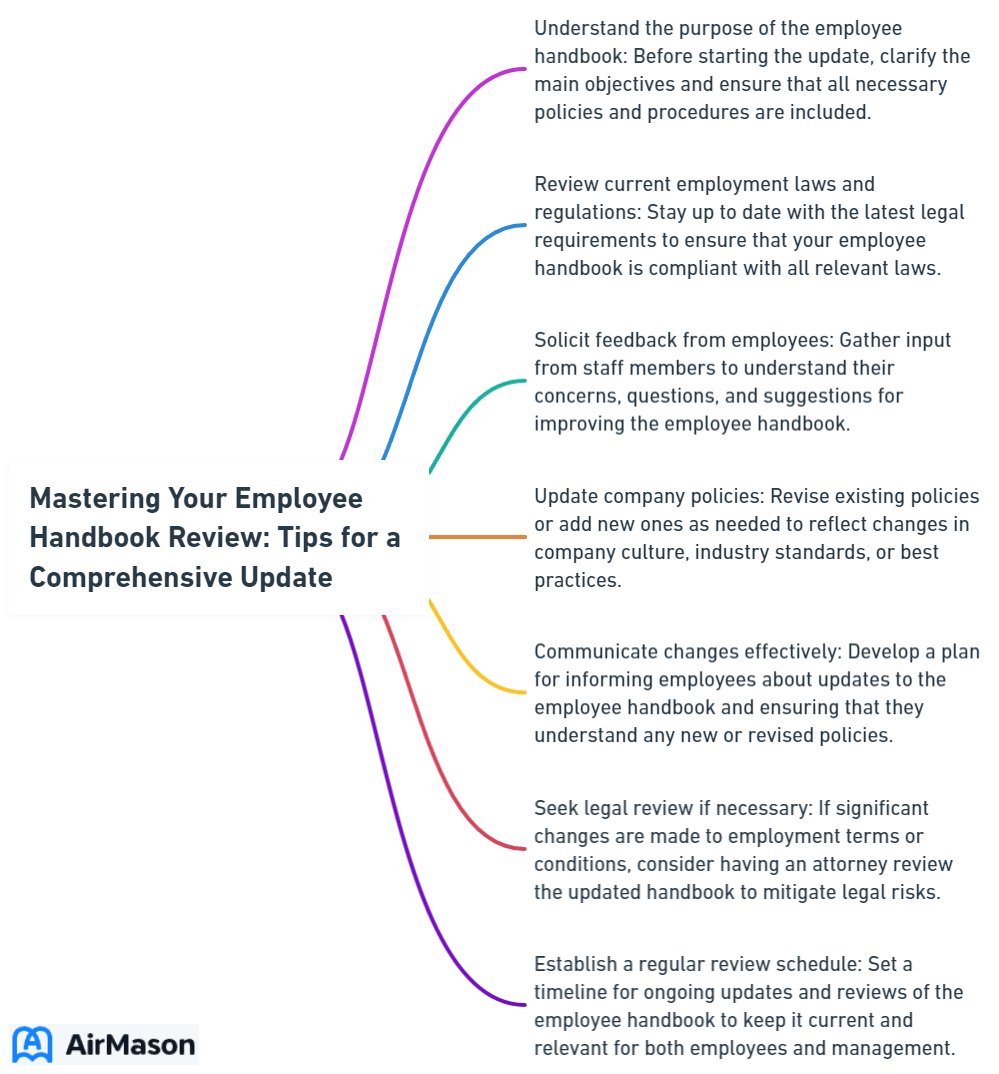
Why is an employee handbook review critical for your business? Our concise guide cuts straight to the chase, elucidating the process of updating your handbook for legal compliance and cultural alignment. Learn the ‘whats’ and ‘whys’ of a thorough review and equip yourself with the necessary tools to refine your handbook, ensuring it serves as a cornerstone of clear communication and company values. Get ready to transform this obligation into an opportunity with our expert tips.
Key Takeaways
- Regular employee handbook reviews are essential for legal compliance, accuracy, and maintaining clear communication and company culture.
- Employee handbooks must reflect current laws and company practices, with special attention to policies on wages, equal employment opportunities, and technology use.
- For a successful review process, companies should gather employee feedback, consult legal professionals, and communicate updates clearly to the staff.
Employee Handbook Clarifications
Employee Handbook Clarifications are essential for ensuring that all employees understand company policies and procedures clearly. These clarifications serve to address any ambiguities or uncertainties that may arise from the language used in the handbook. By providing clear explanations and examples, employees can better comprehend their rights, responsibilities, and the expected code of conduct. Moreover, regular updates to the handbook may necessitate further clarifications to align with changing regulations or company practices. Ultimately, fostering transparency and understanding through these clarifications enhances workplace efficiency and fosters a positive organizational culture.
The Importance of Regular Employee Handbook Reviews

Think of employee handbook reviews as an organizational health check-up, a tool to guarantee smooth and legal operations. Conducting reviews on a regular basis is vital for maintaining accuracy, adhering to the current laws and regulations, and averting potential legal disputes. Additionally, the handbook serves as a vital reference point, establishing clear expectations and offering consistency to safeguard employee rights.
Moreover, your handbook should evolve in tandem with your company. It should reflect any internal and external changes such as cultural shifts and growth, to adequately preserve and reflect the company culture. It is recommended to conduct an internal audit annually, and a professional review by an HR expert or employment lawyer every two years.
Legal Compliance
Legal compliance is the backbone of any employee handbook. Regular reviews ensure it remains compliant with current employment law, thereby protecting the company’s reputation. The handbook must align with relevant labor laws, such as wage and hour policies, anti-discrimination laws, and specific state and local regulations.
For organizations in regulated industries like healthcare, it’s paramount that the handbook addresses industry-specific regulations such as HIPAA, thereby mitigating legal issues related to privacy and other sector-specific requirements. Keeping up with evolving laws, regulations, and court interpretations ensures your handbook accurately reflects the latest employer practices and legal requirements.

Clear Communication
Clarity is the key to effective communication. In an employee handbook, clarity prevents confusion and ensures policies and expectations are well-understood. Ambiguous terms should be well-defined, and examples or scenarios can help illustrate expectations.
Keeping the handbook clear, easy to read and personable enhances its accessibility and inclusivity, thus appealing to a wider range of employees. Ensuring that the handbook is accessible enhances communication, promotes compliance, and contributes to overall employee satisfaction.
Maintaining Company Culture
An employee handbook is also a mirror of the company’s culture. It reflects the organization’s core values and mission, creating a purpose-driven workforce and establishing consistency in policy application. As the company grows, the handbook should evolve to maintain its relevance and impact on the company culture.
Moreover, the handbook should aid in shaping employees’ understanding of the organizational ethos by articulating the company’s mission, vision, and values. A handbook consistent with the company’s culture, which is easy to understand, reinforces uniform application of company policies and accurately reflects the business environment.
Key Elements to Review in Your Employee Handbook

Knowing the significance of regular reviews, what should you prioritize in your employee handbook? To ensure your handbook remains a comprehensive and effective resource, it should comply with applicable laws and regulations, be regularly updated, and include fair and inclusive workplace policies.
You should also assess key policy areas such as wage and hour regulations, equal employment opportunity policies, leave and benefits including military service leave, and technology use to ensure they are clear and specific.
Policies and Procedures
The policies and procedures section is one of the pivotal components of an employee handbook. Regular revisions ensure they are in line with current company practices and compliant with legal standards. Involving employees in leadership positions in the handbook review process can yield greater understanding and acceptance of the necessary changes.
The handbook needs to be clear and practical, avoiding unnecessary complexity, while accurately mirroring actual workplace practices.
Legal Requirements
Ignoring legal requirements in an employee handbook could lead your company straight into a legal minefield. Regular reviews and updates ensure your handbook aligns with changing laws and regulations. Not reflecting recent legal changes can leave companies vulnerable to legal issues, challenges, and penalties.
Adaptations are often required due to shifts in state and local laws, federal employment laws, and local employment laws, so ensure you’re on top of any new relevant laws like Equal Pay for Equal Work and Sick Pay. Specific sections like wage policies and data security must also be updated to comply with the latest local regulations and legal standards.
Company Culture and Values
Your employee handbook also has the power to echo your company’s culture and values. It introduces new employees to what makes the company a great place to work and serves as a legacy. The language and formatting of the handbook should match the organization’s preferred communication style and effectively convey its core values and business philosophy.
By listing unique offerings and describing ways to engage with and benefit from the company’s culture, the handbook can motivate employees to embody the company’s values and maintain an inclusive environment.
Steps for Conducting a Thorough Employee Handbook Review

Conducting a thorough employee handbook review may sound like a daunting task, but it doesn’t have to be. Establishing a schedule for regular reviews helps to keep the process systematic. The essential steps include:
- Identifying the review’s purpose and objectives
- Gathering feedback from employees
- Reviewing and updating existing policies
- Consulting legal professionals if necessary
- Communicating any changes effectively.
Gather Feedback from Employees and Stakeholders
Employee feedback is a goldmine of insights when reviewing your handbook. It ensures that their perspectives and experiences are considered, leading to a more comprehensive and effective resource. Including a diverse range of employee contributions promotes inclusivity and helps identify any content gaps or biases within the handbook.
Reassessing the handbook with managers after receiving initial feedback allows a thorough evaluation of proposed changes and ensures that all considerations are balanced.
Consult with Legal Professionals
Legal compliance is a must, and this is where the role of legal professionals becomes significant. Consulting with them ensures that your handbook complies with applicable laws and legal obligations. They can also help frame disclaimers such as at-will employment statements to prevent misconceptions and clarify the non-contractual nature of the document.
Enlisting an attorney to review the employee handbook showcases the organization’s efforts to uphold employee rights, adhere to legal standards, and prevent potential employee lawsuit situations.
Update and Revise the Handbook
Once you’ve solicited feedback and sought advice from professionals, you can proceed to update and modify the handbook. This involves making necessary cosmetic changes, addressing content gaps, and ensuring the handbook aligns with workplace practices and responsibilities.
Identified gaps and inconsistencies between the handbook and actual company practices should be revised, with a record of policy decision-making. The update process must include revising company policies, benefits, and employee entitlements to reflect current business practices and legal regulations.
Common Pitfalls to Avoid During an Employee Handbook Review

While the process of reviewing an employee handbook might appear simple, it’s easy to encounter certain pitfalls that can result in confusion, inefficient operations, non-compliance, and potential legal complications. These pitfalls include overlooking legal compliance, having inconsistent policies, and using ambiguous language.
Overlooking Legal Compliance
Overlooking legal compliance in your handbook can have serious consequences. It may imply contractual terms leading to potential lawsuits. Inclusion of expired laws or outdated policies can lead to legal disputes and liabilities. A legally compliant handbook serves as a key defense mechanism in the event of employment litigation. Therefore, regular updates and legal reviews are essential.
Inconsistent Policies
Inconsistent policies in your handbook, including employee conduct policies, can create confusion about employment terms and conditions, such as employee classifications and payroll practices. This confusion can lead to unequal treatment of employees due to a lack of clear guidelines.
Operations can become ineffective when employees act on incorrect policies, as they may not be in line with the current company’s practices.
Ambiguous Language
Ambiguous language in your handbook can lead to misunderstandings and a lack of adherence to company standards. It can be interpreted in ways that differ from the employer’s intentions, leading to inconsistencies with present policies or practices. Therefore, the tone of the handbook should be positive, professional, and understandable, avoiding legal jargon and confusing terminology.
Implementing Changes and Communicating Updates

Once you’ve reviewed, updated, and revised your employee handbook, it’s time to implement the changes and communicate updates to your staff. This can be done by redistributing the entire handbook or only the updated policies, followed by training or explanatory sessions for employees to understand new policies and their impact.
Updating the Employee Handbook
When updating the handbook, remember to make necessary cosmetic changes, like changes in company leadership or correcting typos. Also, include a ‘Confirmation of Receipt’ signature page for employees to acknowledge having received and read the updated policies.
Communicating Updates to Employees
The act of communicating updates to employees holds as much importance as the updates themselves. You might want to consider a variety of communication methods, including:
- Face-to-face meetings
- Emails
- Newsletters
- Digital platforms
Providing ample notice before changes take effect gives staff time to adapt and ensures a smooth transition. Encourage employees to provide feedback on the changes and sign an acknowledgement form to demonstrate their awareness of the updated content.
SHRM Sample Employee Handbook
The SHRM sample employee handbook serves as an invaluable resource for organizations seeking to establish comprehensive guidelines and policies for their workforce. Designed by experts in human resources management, this handbook offers a framework that addresses various aspects of employment, including but not limited to, code of conduct, benefits, leave policies, and performance expectations. By utilizing the SHRM sample employee handbook, companies can ensure consistency in communication and enforcement of rules, fostering a positive work environment while mitigating potential legal risks. This comprehensive document serves as a foundational tool for organizations to align their practices with industry best practices and regulatory standards, ultimately contributing to the overall success and well-being of both employees and the company.
Summary
In conclusion, regularly reviewing, updating, and effectively communicating changes in your employee handbook is crucial. It not only ensures legal compliance and clear communication but also helps maintain your company’s culture and values. By avoiding common pitfalls and implementing a systematic review process, your handbook can remain an invaluable tool for your organization.
Frequently Asked Questions
How do you conduct an employee handbook review?
To conduct an employee handbook review, first assess its clarity, accuracy, and consistency. Make sure the handbook is written in clear, simple terms and reflects the employer’s actual practices.
How often should an employee handbook be reviewed?
Employee handbooks should be reviewed and updated at least once a year to ensure they accurately reflect current employment laws and regulations, as well as any industry-specific regulations.
Are employee handbooks a good idea?
Yes, employee handbooks are a good idea as they can protect your business from lawsuits and provide new hires with important insights into your organization’s values and mission.
What is a legal review of employee handbook?
When conducting a legal review of an employee handbook, it is important to audit the included policies, such as wages, leave, benefits, and conduct, to ensure compliance with federal, state, and local laws. Reviewing wage and hour policies is crucial to confirm compliance with relevant laws.
What are some common pitfalls to avoid during a handbook review?
When reviewing a handbook, be sure to avoid common pitfalls such as overlooking legal compliance, having inconsistent policies, and using ambiguous language. These can impact the effectiveness and clarity of the handbook.
Important Disclaimer:
Please be aware that the content on this page has been generated by using artificial intelligence language models and may contain errors, inconsistencies, or outdated information. It is provided as-is without any warranties or guarantees of accuracy.
We strongly recommend using this content as a starting point for further research. We disclaim any liability for damages or losses resulting from the use or reliance on this content.